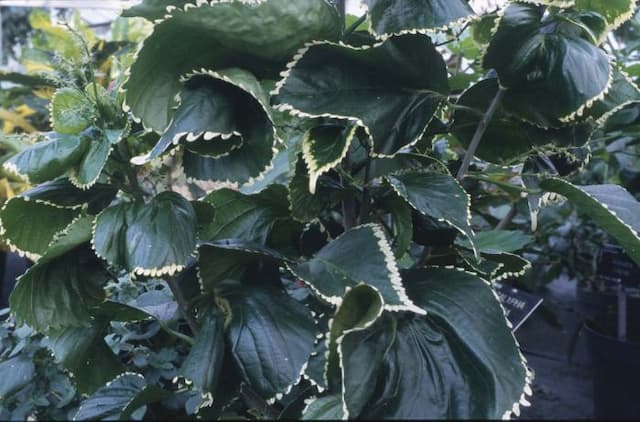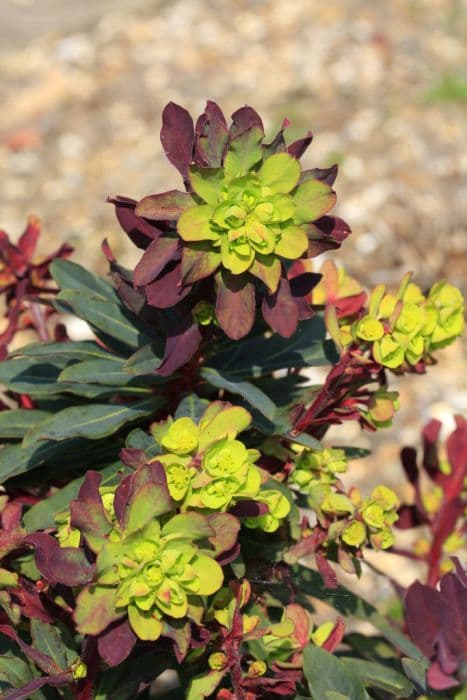Spurge Euphorbia 'Copton Ash'

ABOUT
Euphorbia 'Copton Ash' is a striking succulent perennial that features a robust, bushy form with upright stems. Its foliage typically exhibits a vibrant green hue with leaves that are often narrow, elongated, and slightly curved, resembling a sickle. In contrast to their lush green backdrop, the plant's tips may showcase a contrasting color, especially under certain environmental stressors like cooler temperatures or bright sunlight, which may accentuate red, pink, or purple hues. Throughout the growing seasons, 'Copton Ash' may produce flowers that, while small and not the primary attraction, add to its interest. These flowers are usually surrounded by eye-catching bracts that contribute to the plant's ornamental value. The subtleties of its appearance can vary depending on the growing conditions, enhancing its unique qualities and offering visual interest throughout the year. The overall impression of Euphorbia 'Copton Ash' is one of a striking and distinctive plant that provides texture and color to gardens and landscapes, regardless of its size or spread.
About this plant
 Names
NamesFamily
Euphorbiaceae
Synonyms
Copton Ash Spurge
Common names
Euphorbia 'Copton Ash'.
 Toxicity
ToxicityTo humans
Euphorbia 'Copton Ash', commonly known as spurge, contains a milky sap that is toxic to humans. If ingested, the sap can cause severe irritation to the mouth, throat, and stomach, leading to symptoms such as nausea, vomiting, and diarrhea. In some cases, contact with the skin can result in dermatitis, while contact with the eyes can cause intense pain and temporary blindness. It's important to handle this plant with care and seek medical attention if any part is ingested or if the sap gets into the eyes or on the skin.
To pets
Spurge is toxic to pets. The milky sap contains toxins that can cause similar reactions in animals as in humans. If ingested, a pet may experience symptoms like vomiting, diarrhea, and drooling due to irritation of the mouth and gastrointestinal tract. In some cases, skin contact with the sap can lead to dermatitis, and if the sap gets into the eyes of a pet, it can cause pain and potentially temporary blindness. It is critical to prevent pets from ingesting or coming into contact with this plant and to consult a veterinarian immediately if exposure occurs.
 Characteristics
CharacteristicsLife cycle
Perennials
Foliage type
Evergreen
Color of leaves
Green
Flower color
Yellow
Height
2 feet [60 cm]
Spread
2 feet [60 cm]
Plant type
Shrub
Hardiness zones
7
Native area
Mediterranean
Benefits
 General Benefits
General Benefits- Low Maintenance: Euphorbia 'Copton Ash' is known for requiring minimal care, which makes it suitable for novice gardeners or those with busy lifestyles.
- Drought Tolerant: Once established, this plant has a high tolerance for dry conditions, reducing the need for frequent watering.
- Pest Resistance: Due to its toxicity, it is generally resistant to browsing by deer and other herbivores, as well as many pests.
- Year-Round Interest: It offers varying interest throughout the seasons with its evergreen foliage, colorful bracts, and structure.
- Architectural Shape: With its distinct, upright form, it can add structure and interest to garden designs.
- Attracts Pollinators: Euphorbia 'Copton Ash' produces flowers that can attract pollinating insects, benefiting the local ecosystem.
- Adaptable: This plant can thrive in a variety of soil types, as long as they are well-drained.
- Decorative Purposes: Its unique appearance can be used in floral displays and as a focal point in gardens and landscapes.
 Medical Properties
Medical PropertiesThis plant is not used for medical purposes.
 Air-purifying Qualities
Air-purifying QualitiesThis plant is not specifically known for air purifying qualities.
 Other Uses
Other Uses- Photography Prop: The unusual form and vibrant color of Euphorbia can add visual interest in both amateur and professional plant photography.
- Textile Dye: Some Euphorbia species can be used to produce a natural dye for fabrics, offering an eco-friendly alternative to synthetic dyes.
- Artistic Inspiration: Artists may use the unique shapes and textures of Euphorbia as inspiration in painting, sculpture, or design work.
- Study Subject: Euphorbia can serve as an interesting subject for botanical studies and educational purposes in schools and universities.
- Insect Habitat: The plant may offer shelter and food for certain insect species, thus contributing to local biodiversity.
- Plantscaping: Euphorbia can be used in themed gardens, such as a succulent or xeriscape garden, to create a visually appealing landscape.
- Craft Material: Dried parts of Euphorbia can be used in floral arraignments or as components in craft projects.
- Festive Decoration: During specific holidays, such as Halloween or Christmas, Euphorbia can be used as a seasonal decorative element due to its striking appearance.
- Cultural Symbolism: In some cultures, Euphorbia may be associated with certain traditions or used in social ceremonies.
- Educational Tool: Botany educators can use Euphorbia to demonstrate plant adaptation, survival strategies, and the variety of plant forms to students.
Interesting Facts
 Feng Shui
Feng ShuiThe plant Euphorbia is not used in Feng Shui practice.
 Zodiac Sign Compitability
Zodiac Sign CompitabilityEuphorbia is not used in astrology practice.
 Plant Symbolism
Plant Symbolism- Resilience: Euphorbia plants, also commonly known as Spurge, are known to be hardy and can thrive in challenging environments, symbolizing the ability to endure and overcome difficulties.
- Protection: Spurges are often associated with protection due to the toxic sap they contain, which deters herbivores, representing a protective barrier against harm.
- Healing: Historically, some varieties of Euphorbia have been used in traditional medicine, and thus they can represent healing.
- Purification: In some cultures, Spurge plants have been used in rituals or as a tool to ‘purify’ by emitting a strong, repelling scent that is believed to cleanse the air or ward off evil spirits.
 Water
WaterThe Spurge, which is the most common name for Euphorbia 'Copton Ash', should be watered thoroughly but infrequently, allowing the soil to dry out completely between waterings. This typically means watering it once every one to two weeks, but this can vary depending on environmental conditions such as temperature and humidity. When you do water the Spurge, use enough water so that it runs through the drainage holes, which may be around 12 to 16 ounces for a pot with a diameter of 6 inches. It is crucial to avoid overwatering as it can lead to root rot, so it's better to err on the side of less water rather than more.
 Light
LightThe Spurge thrives best in bright, indirect sunlight but can also tolerate partial shade. It should be placed near a sunny window where it can receive plenty of light but should be protected from the harsh, direct afternoon sun that can scorch its leaves. An east or west-facing window is often ideal for providing the perfect balance of light for the Spurge.
 Temperature
TemperatureThe Spurge prefers a temperature range between 60 and 75 degrees Fahrenheit but can endure temperatures as low as 50 degrees and as high as 80 degrees. It is not frost-tolerant and should be kept away from drafts and sudden temperature changes to maintain a steady growing environment. The ideal temperature for robust growth lies within the warmer part of its tolerated range.
 Pruning
PruningPrune the Spurge to control its shape and size as well as to remove any damaged or diseased foliage. The best time to prune is in the late winter or early spring before new growth begins. This plant may not require frequent pruning; doing so once a year is often sufficient. Always wear gloves when pruning the Spurge, as the sap can be irritating to the skin.
 Cleaning
CleaningAs needed
 Soil
SoilFor Spurge 'Copton Ash,' the ideal soil mix is well-draining with a blend of potting soil, coarse sand, and perlite in equal parts. It prefers a slightly acidic to neutral pH, ranging from 6.0 to 7.0.
 Repotting
RepottingSpurge 'Copton Ash' should be repotted every two to three years to refresh the soil and accommodate root growth. Repot in the spring or early summer for the best results.
 Humidity & Misting
Humidity & MistingSpurge 'Copton Ash' is tolerant of a wide range of humidity levels but prefers average room humidity around 40-50%. Avoid extremely high humidity to reduce the risk of fungal diseases.
 Suitable locations
Suitable locationsIndoor
Place Spurge 'Copton Ash' in bright, indirect light indoors.
Outdoor
Plant Spurge 'Copton Ash' in full sun to partial shade outdoors.
Hardiness zone
6-9 USDA
 Life cycle
Life cycleEuphorbia 'Copton Ash', commonly known as Spurge, begins its life cycle as a seed, which, upon finding suitable soil and climatic conditions, germinates and develops into a seedling. The seedling grows, forming a root system and foliage, and eventually matures into an adult plant with characteristic dense, bushy greenery and small, typically greenish-yellow flowers surrounded by colorful bracts. As an adult, Spurge undergoes a flowering phase annually, typically in spring or early summer, attracting pollinators for fertilization. After pollination, the plant produces fruit which are capsules containing seeds that, when mature, burst open to disperse the seeds. These seeds may lie dormant until the next growing season or germinate immediately if conditions are right. This perennial plant continues to grow and may spread vegetatively if conditions are favorable, with parts of the plant potentially rooting to form new individuals, while older parts of the plant eventually die off after several years.
 Propogation
PropogationPropogation time
Spring-Early Summer
The most popular method of propagation for Euphorbia 'Copton Ash', commonly known as Spurge, is through cuttings. This method is best done during spring or early summer when plant growth is most active. To propagate, select a healthy stem and cut a 3 to 4 inch (about 7.5 to 10 cm) length below a leaf node using a clean, sharp knife or scissors. The sap of Spurge can be irritating, so it's crucial to wear gloves during this process. Let the cutting dry for a day to let the cut end form a callus, which helps to prevent rot when planted. Dip the callused end into a rooting hormone for better root development, and then plant the cutting in a well-draining soil mix. Keep the soil slightly moist, and in a few weeks, the cuttings should develop roots and eventually grow into new plants.



![Spurge [Blackbird]](/_next/image?url=https%3A%2F%2Fplants-admin.emdemapps.com%2Fimages%2Fplants%2F%2Fimages%2F604b535f37783.png&w=640&q=75)





